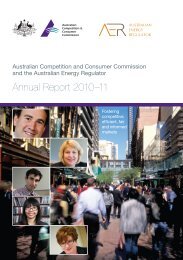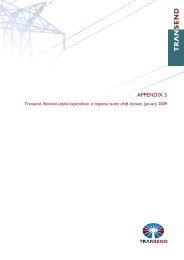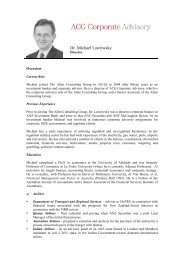Internal consistency of risk free rate and MRP in the CAPM
Internal consistency of risk free rate and MRP in the CAPM
Internal consistency of risk free rate and MRP in the CAPM
You also want an ePaper? Increase the reach of your titles
YUMPU automatically turns print PDFs into web optimized ePapers that Google loves.
at<strong>in</strong>g one notch to <strong>the</strong> equivalent <strong>of</strong> AA-, br<strong>in</strong>g<strong>in</strong>g it <strong>in</strong>to l<strong>in</strong>e with S&P’s rat<strong>in</strong>g,<br />
which had been downgraded earlier <strong>in</strong> <strong>the</strong> year. Despite rat<strong>in</strong>g changes, longterm<br />
government bond yields <strong>in</strong> <strong>the</strong> United States <strong>and</strong> Japan have fallen<br />
s<strong>in</strong>ce <strong>the</strong> start <strong>of</strong> August as <strong>risk</strong> aversion has grown. (Emphasis added)<br />
104. In <strong>the</strong> same document <strong>the</strong> RBA reite<strong>rate</strong>s <strong>the</strong> fact that <strong>the</strong> fall<strong>in</strong>g CGS yields <strong>in</strong> <strong>the</strong><br />
second half <strong>of</strong> 2011 were contemporaneous with heightened <strong>risk</strong> aversion: 29<br />
Risk aversion <strong>and</strong> volatility <strong>in</strong> global f<strong>in</strong>ancial markets have <strong>in</strong>creased<br />
sharply s<strong>in</strong>ce <strong>the</strong> start <strong>of</strong> August (Graph 1.1) …. Across many countries,<br />
prices <strong>of</strong> shares <strong>and</strong> o<strong>the</strong>r <strong>risk</strong> assets have decl<strong>in</strong>ed sharply s<strong>in</strong>ce early August.<br />
Bank <strong>and</strong> <strong>in</strong>surer share prices have been particularly affected, fall<strong>in</strong>g by more<br />
than 15 per cent <strong>in</strong> most countries, to be around <strong>the</strong>ir lowest levels s<strong>in</strong>ce early<br />
2009 (Graph 1.2)…<br />
This current episode <strong>of</strong> <strong>risk</strong> aversion <strong>and</strong> volatility follows a number <strong>of</strong><br />
periods <strong>of</strong> heightened market turbulence over <strong>the</strong> past couple <strong>of</strong> years.<br />
These periodic events <strong>in</strong>dicate that f<strong>in</strong>ancial market participants rema<strong>in</strong> sensitive<br />
to bad news follow<strong>in</strong>g <strong>the</strong> experience <strong>of</strong> 2008–09. While <strong>the</strong> latest bout <strong>of</strong> market<br />
uncerta<strong>in</strong>ty is not on <strong>the</strong> scale <strong>of</strong> 2008–09, it is unclear at this stage whe<strong>the</strong>r it<br />
will be ano<strong>the</strong>r temporary episode or whe<strong>the</strong>r it is foreshadow<strong>in</strong>g a more serious<br />
market dislocation. (Emphasis added)<br />
105. It is important to underst<strong>and</strong> that it would be an error to argue, based on <strong>the</strong> last<br />
sentence <strong>of</strong> this quote, that <strong>the</strong> regulatory <strong>MRP</strong> should not be <strong>in</strong>creased to reflect<br />
heightened uncerta<strong>in</strong>ty/<strong>risk</strong> aversion because this may only be temporary. Even if we<br />
know that <strong>the</strong> heightened <strong>risk</strong> aversion is temporary (which we do not), if we are us<strong>in</strong>g<br />
prevail<strong>in</strong>g CGS as our estimate <strong>of</strong> <strong>the</strong> <strong>risk</strong> <strong>free</strong> <strong>rate</strong>, we must still reflect even<br />
temporarily higher <strong>MRP</strong> levels <strong>in</strong> our cost <strong>of</strong> equity estimate. To do o<strong>the</strong>rwise would<br />
be to pass through a temporarily lower CGS yield that is <strong>the</strong> ‘o<strong>the</strong>r side <strong>of</strong> <strong>the</strong> co<strong>in</strong>’ <strong>of</strong><br />
temporarily higher <strong>risk</strong> aversion.<br />
5.2. Specific supply <strong>and</strong> dem<strong>and</strong> conditions <strong>in</strong> <strong>the</strong> CGS market<br />
106. Figure 10 <strong>and</strong> Figure 11 above clearly illust<strong>rate</strong> <strong>the</strong> negative relationship between <strong>risk</strong><br />
premiums <strong>and</strong> <strong>the</strong> <strong>risk</strong> <strong>free</strong> <strong>rate</strong> that is driven by <strong>the</strong> flight to safety <strong>of</strong> CGS <strong>in</strong> periods<br />
<strong>of</strong> heightened <strong>risk</strong> aversion. However, <strong>the</strong>re is good reason to believe that <strong>the</strong>re are<br />
current aspects <strong>of</strong> <strong>the</strong> supply <strong>and</strong> dem<strong>and</strong> dynamics for Australian CGS that will tend<br />
to depress CGS yields, <strong>and</strong> raise <strong>risk</strong> premiums, even <strong>in</strong> periods <strong>of</strong> ‘normal’ market<br />
conditions. Specifically, <strong>the</strong> experience <strong>of</strong> recent years is likely <strong>the</strong> supply <strong>of</strong> CGS is<br />
small relative to <strong>the</strong> size <strong>of</strong> <strong>the</strong> Australian economy <strong>and</strong>:<br />
29 Ibid, pp. 5-6<br />
� <strong>in</strong>ternational events have seen a significant <strong>in</strong>crease <strong>in</strong> dem<strong>and</strong> for CGS by<br />
foreign <strong>in</strong>vestors; <strong>and</strong><br />
Competition Economists Group<br />
www.CEG-AP.COM<br />
28







